Menus
- Discovery
- In the saddle
- Contact
- In the city
- Highway
- Departmental
- National
- Braking
- Tires
- Duo
- Convenient
- Consumption
- Conclusion
First motorcycle to overtake
the legendary 300 km / h bar, kilometer standing start
in less than 18 seconds, the Hayabusa was talked about from
its output with its 175 horses in free version, with great reinforcement
speed comparison with the TGV … within reach of
all budgets. Almost 10 years later, she’s less than ever
politically correct, but it hasn’t aged
aesthetic apart from the disappearance of the number 300 km / h on
the counter. Only a few modifications made between 1999
and 2001 made it possible to correct some early problems:
timing chain tensioner, torque limiter, gearbox
at speed, starter. In the end, this model had a
exceptional longevity for this sport category…
even if we are talking about a new
Hayabusa model for 2008.
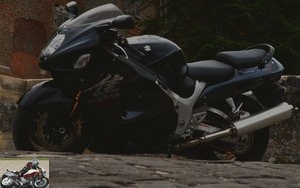
Discovery
Meaning Falcon in Japanese, the Hayabusa has a side
stocky, low and long. It immediately imposes by its size and
its curves, especially against the latest sports cars with sharp lines.
Long muzzle, superimposed double optic, saddle
two stages, classic double exhaust, the more
approach, the more it gives an impression of heaviness.
On the dashboard side, everything is there, on a carbon background but
analog only: speedometer, tachometer,
partial double trip, totalizer, clock, fuel gauge, temperature
of water. The warning is here placed on the right handlebars, easily
started with the thumb.
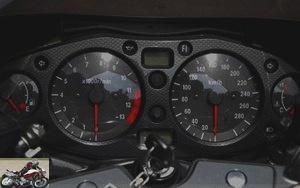
In the saddle
The saddle is low (805 mm) and thin and there is hardly any
need to step over, anyway no more than any
roadster. The 1.70 pilot touches the ground with the soles of his feet,
but the weight being placed so low, that the weight of
the bike does not feel.
The bust leans slightly forward and the
hands fall on the handlebars, resting on the wrists, but not excessively.
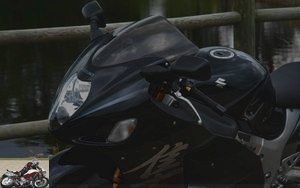
Contact
Key entered, clutch engaged, the counter resets.
The pot immediately rumbles.
The first starts with apprehension, but the
motorcycle leaves on a net of gas, without violence. Hayabusa is taken
in hand easily, much more easily especially than its external template
don’t let him fear. The box turns out nice.
Even the engine shows docility and smoothness
impressive, without violence in first, and able to wind
in 6th gear at 1500 rpm. Is it really the famous GSXR 1300 cc that
made the government tremble? or is it a version
flanged 34 hp ?
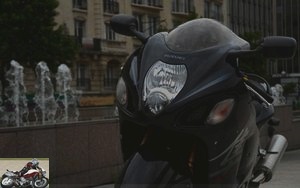
In the city
Hayabusa does not particularly encourage
turn the handle, with an almost "wise
»Because of the enormous torque available at low revs.
It is capable of winding at 1200 rpm in 6th gear and starts
to push from 3500 rpm. But even doing
be careful, you have to watch the meter: you can easily find yourself
at 90 km / h in the city while having the impression of being
at 40 km / h and be careful! Easy to learn, and terrible
object to keep your license !
Despite her imposing exterior size, she sneaks
easily between lines, as easily as a roadster.
The position is not so much that in support
on the wrists, it is even possible to do regularly
the back and forth work in town of 20 km without problem there
where wrists scream thanks on other machines.
Only complaint in town, with a position resting on the wrists,
the head remains above the bubble, and suddenly, the meter is
only partially readable.
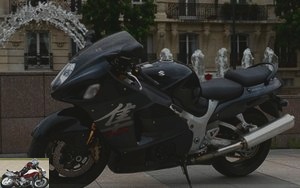
Highway
The Hayabusa soars with power on the highway…
either in first at 130 km / h, or in 6th at 4200 rpm.
At 5,000 rpm, it is already at 150 km / h and beyond
legal speed. The bubble still protects up to
170 km / h (also the maximum speed of 2nd gear) but admit
its limits then, all the more so for large sizes which
will automatically rise – and with good reason – a high bubble to improve
protection.
Handling remains impressive at high speeds –
speed much too quickly too high elsewhere – and all
with disconcerting ease; so disconcerting
that we would tend to forget all caution.
The saddle is rather comfortable and allows long journeys without
tired. Thus, faced with other competitive hypersports, the Hayabusa
is now more of a sportivo-GT than an exclusive hypersport.
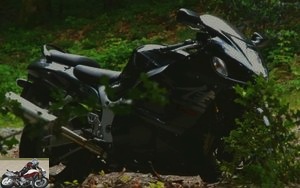
Departmental
Even if the Hayabusa finds its hunting ground on the highway,
she does not disdain the small, curvy roads, on the contrary.
The weight is still forgotten here. It is easily placed at the entrance
curve and effortlessly follows the trajectory unperturbed.
The cycle part is royal, including on bad coating. The
driving is easy. In addition, capable of winding
between the 4th and the 5th in a pleasant way, at a pace
sustained, the Hayabusa takes a pleasant
turn to another. Only the couple present at
low revs and the available power can bring in too much
fast, too strong in a curve … and then you have to stay in control
of the machine. But as soon as we slow down a bit,
the bike swings very easily from turn to turn.
the other.
The only difficulty appears in the mountains when the virolos
are very tight and very fast. The Hayabusa does not chain
not the pif-paf with as much liveliness as a 600 sport. Therefore,
it gets a little more physical if you want to try to keep up.
Because with the Hayabusa the sequences are more smooth
that liveliness.
The fact remains that the departmental remains a field
most enjoyable game.
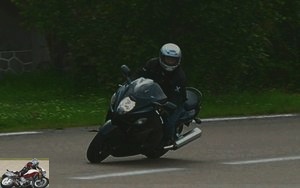
National
The national road ultimately represents the place where the Hayabusa
can once again give the best of herself between
straight lines and large curves. Available from 3,000 rpm for
strong acceleration, it easily rolls up
VERY / Too high speed the large curves available without any apprehension.
There, or on departmental roads, it was necessary to measure the power
so as not to be overwhelmed too quickly by skills
of the motorbike, on national, there is more margin … but also more
easy ways to lose your license !

Braking
The rear brake is a decent retarder. Front brake
dose easily, with a good feeling, without being too violent.
We could blame him for a very slight lack of bite,
but if we really take it up, it slows down very
well and largely up to the performance of the bike.
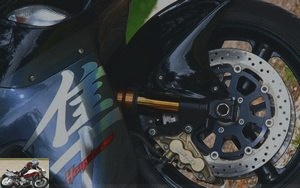
Tires
Originally fitted with Bridgestone BT 56, the Hayabusa is
now fitted with BT014 at the rear and BT 56
in the front.
Duo
The saddle is almost thick for the category, with
handles well placed, and not too high. It is therefore possible
to make long trips as a duo, with just petrol breaks.
The shock absorber is well adjusted from the factory and offers
an excellent compromise between rigidity, comfort and erasing of defects
bitumen.
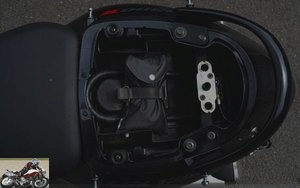
Convenient
There is room under the passenger seat for a large U and two pants
rain.
The U is easily placed at the level of the front wheel.
Lashing hooks allow easy hanging
a bag.
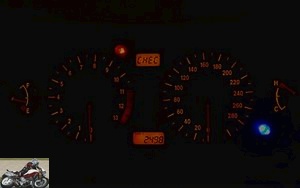
With its very large couple, the Hayabusa devours all
the tire mounts (approved for this machine therefore BT014,
BT56, D207, or even D208), often in 3,500 km, at best in 6,000 km.
Despite little theft and accident, in relation to the category,
insurance remains difficult to obtain at a reasonable price,
unless you have years of license and a bonus
max. In which case, in All Risks, it can go down in some cases
at € 1,000 but rather around € 2,000 at
year.
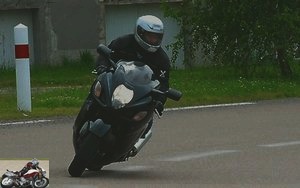
Consumption
As it is possible to wind on the torque, the consumption
can turn in very cool driving around 5 liters per hundred,
but otherwise rather around 5.9 liters per cent when driving
normal. This then authorizes 310 km of autonomy, before reserve.
By increasing the pace, consumption can go up to
9, or even 10 liters per hundred and the reserve then runs as soon as
200 km.
The fuel gauge is not an example of reliability but
accumulated during the partial trip allows you to know where you are. Tank
well filled, the gauge does not move during the first 100 kilometers
with a needle at the cleat. The needle is then positioned in the middle
towards 150-160 km, then lick the red zone towards 250 km (in
quiet driving). The reserve lights up towards the bottom of the zone
red, once at 310 km, when driving particularly
cool, with a tank of 17.2 liters made at 340 km (so there was
still a little margin).
As a "comparison" on an identical route and pace
(if we can make a comparison with such a difference in
displacement and power), it consumes 5.4 liters per hundred,
where an ER-6 consumes 4.2 l * and 5 liters there
or an ER-6 consumes 3.9 liters.
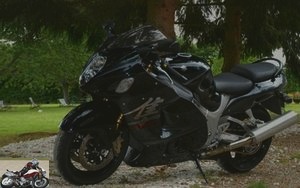
Conclusion
Easy, comfortable, especially considering the power available, the Hayabusa
hides his game well and gives full of sensations, including to
little rhythm, where the full 248 kilos are forgotten
easily. It does not necessarily encourage turning the
handle, although it easily takes
shameful speeds (250 km / h in the restricted version, 310 km / h in the
unbridled). In fact, its danger lies as much in
its fabulous power than in its ease of driving, which makes
easily ride over his pumps. That said, braking follows,
and the curves are linked together easily, the bike revealing itself
particularly docile. So even though it’s a motorcycle
to be reserved for an experienced biker, having already
a good experience, it is much less exclusive or violent
than a GSX-R 1000, to be reserved for pilots.
Its only flaw lies in the vibration noises of the
plastic of the fairing at certain speeds and especially
its high consumption of consumables … requiring a budget
not insignificant, adding to its initial price of
13,299 € (negotiable) and the insurance invoice.
In the end, it’s a motorcycle with a big heart like that
and a softness under a somewhat clumsy appearance, which it is not
not at all. Only its price and the consumables bill can make
hesitate: a motorbike to reserve unfortunately at
an elite with a full wallet.
Strong points
- Motor
- Easy to get started
Weak points
- Cost of consumables: tires, chain
- Vibrations in the bubble
- No central stand
Competitors: Honda CBR XX, Kawasaki
ZX-12R
Datasheet
| Reader essays
on the Tests forum
Related articles
-
197 hp at 9,500 rpm, 155 Nm at 7,200 rpm, 3 engine maps, 300 km / h, € 15,499 Cut for speed, does the myth stand up to the ravages of time? ? Thursday 11…
-
Suzuki DL 650 VStrom motorcycle test – 2012 vintage
Aids for the road 10 years of good and loyal service … the DL 650 VStrom indeed celebrates a nice anniversary in 2012, without having succeeded in…
-
Birthday 4 cylinders in line, 1000 cm3, 202 hp, 117 Nm, 203 kg all full facts, 19,599 euros. Nice idea to resuscitate the R version of the GSX-R (the…
-
GT almost Sport – 4,000 km test Appeared in 2001, winning ABS in 2002, the FJR is the quintessential Yamaha GT, including the gimbal. Just below 15,000…
-
The handyman The Suzuki GS 500 is the queen of motorcycle schools: a twin-cylinder of 500 puncture-proof cc at a minimum price, launched in 1989, and…
-
The Burgman is the line of Suzuki scooters, available in 125, 200, 400 and 650 cm3. The 400 version is aesthetically very close to the 125 version, and a…
-
Honda CB 1300 S motorcycle test
The CB 1300 is the big Honda roadster in the line of the Bandit 1200 and XJR 1300. Introduced in 2003 in the spirit of the Big One, the CB 1300 belongs…
-
Japanese Spice Choper. When Honda introduced the Fury in 2009, no one believed it … what could have prompted a Japanese brand to create such an extreme…
-
Suzuki Bandit 650 N motorcycle test
Released for good behavior Appeared in 1995, the Bandit has continued to evolve, going from the first nasty roadster to a beefy roadster but leaving…
-
Yamaha XVS 1300 Midnight Star test
The punchy custom The XVS Midnight Star is the 2007 evolution of the old Dragstar, the custom Yamaha, clearly designed for the American market. With a…
I couldn’t change the settings of the Street I rode on, but by default the R was much harder.
But I’m waiting for the test drives, hoping that they won’t settle for slick roads like a circuit, and that they will tweak the settings if necessary. It’s super important to me, since I live in Belgium where the roads are in poor condition …
On my Speed, the preload settings were relatively accessible, if only Triumph had provided the wrenches to do so in the tool kit! : -S
Ah, and also: on a real TTX36, there is a trim setting missing here.
Even if it means exhuming a post to note the mistakes, you might as well send an email to the team with your corrections … no?
thanks in advance.
With no mile on the road, all assumptions are allowed, the worst as well as the best. My personal experience (relatively long, 35 years of testing everything that runs) has shown me that the benefit of good quality suspensions is appreciated in all circumstances. And until proven otherwise, Ohlins is very much in control, let it be with Ducati Where with Triumph on the Daytona R.
The double compression adjustment is not part of the characteristics of the NTX 36 shock absorber (see the official Ohlins website where there is a very interesting explanation of the principle of the twin tube). On the other hand, it is true that the element mounted on the Speed Triple R does not have a system for adjusting the spring preload by means of a cylinder, which means that you have to snag on a double crenellated ring. An operation almost impossible to perform elsewhere than in the workshop. Hence I think the lack of recommendations in the table provided by Triumph whereas, as you say very well, this is the first point on which to intervene when going from solo to duo.
As far as your own experience with the Speed is concerned, its behavior absolutely does not correspond to what I have experienced with this bike, which I have ridden many times in the course of several thousand kilometers. I have found that the fashion for riders who "go hard" is to brake their suspensions considerably in hydraulic compression, which to me is an aberration. It makes motorcycles uncomfortable, it accentuates the tendencies to handlebars, even it causes them on motorcycles which are not subject to it … The only thing that I recognize in this measure is to attenuate the phenomena of direction which stiffens or is straightens when braking while the motorcycle is on an angle. A trend that has diminished well on recent sports cars and roadsters and that current high-performance tires have also greatly diminished.
Another point that can explain the uncontrollable side of your Speed, the preload of the rear spring. Contrary to what we spontaneously imagine, it is sometimes necessary to increase the preload to obtain comfort. It can happen that under the effect of the weight of the bike and its rider, the suspension sinks excessively, to the point of absorbing a large part of the theoretical travel. Suddenly we end up with a suspension that works from the outset in an area designed to withstand significant shocks and is unable to filter the slightest bitumen cracks.
Last point, ABS. If the people in charge of Triumph thought that it was better to disconnect it, it is not because they do not trust it but rather to go to the front of the unpleasant remarks of the journalists who would have, it is certain, claimed body and cry that it is suppressed. With good suspensions, grippy tires and today’s electronics, it’s hard to make ABS that isn’t perfectly efficient.